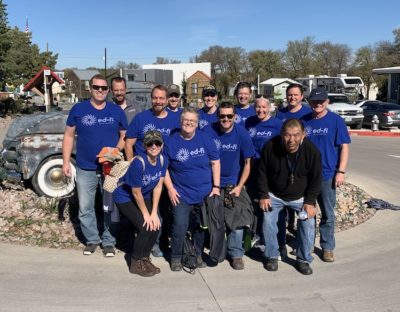Last month, Amazon Web Services hosted its annual re:Invent conference in Las Vegas. The conference has a tremendous variety of content and hands-on materials for building services on the AWS platform. A principal—if not the principal—reason to attend this conference each year is to understand how current technology services and trends are shaping data management and use in other industries, and how those innovations might apply to K12 education and to the Ed-Fi community.
This year’s re:Invent conference did not disappoint on that front, and I left with a few important takeaways and reflections from my time there.
Data Warehouses Giving Way to Data Architectures
Organizations are migrating away from the concept of a unified “data warehouse” towards a unified “data architecture.” These architectures often allow departmental units to define local data schemas and entities, rather than trying to attempt a rationalization of all data schemas and models by a centralized unit or governance structure. Rather than define a unified schema, the organization invests in common data services that allow individual departments to exchange and access the data they need, often in a publish/subscribe model.
One advantage of these architectures is that they allow for purpose-built data storage for different kinds of databases, rather than force a “one-size fits all approach” as an organization goes about selecting storage systems. This allows for the co-existence of a variety of tools: relational, document-based, graph-based, and others depending on the needs and use cases.

One keynote overflow area featured giant amoeba-like beanbags. My request for these as general seating at the 2020 Tech Congress has already been denied!
The Cloud Moves Beyond Bare Metal
The conference also made it clear that it’s misleading to think of the “cloud” only as on-demand, high-availability basic infrastructure. Increasingly, cloud providers are packaging up common architectural patterns for services, expanding the definition of what infrastructure is far beyond computing, storage, and networking. AWS services like Cognito, Step Functions, App Sync and others are highly articulated infrastructure applications and a far cry from basic bare metal infrastructure. On other platforms such as Microsoft Azure, you can find a similar catalog of services.
Applications of the future are more likely to be assembled like Legos, gluing together various services rather than hand-crafting code for those services. AWS’s catchphrase for abstracting these reusable elements in services is, “removing the undifferentiated heavy lifting.” Don’t worry developers, there will still be business logic to encode (probably more of it) as service-level operations will increasingly be accessed as configuration options.
Machine Learning Has Matured, But Not “Crossed the Chasm”
Machine learning, a subset of artificial intelligence, seems likely to be one of the most transformative technologies of this computing era. I’ll admit that I was skeptical of machine learning for a while; haven’t we always had the ability to perform correlation analysis on data? Years ago, I did a year of graduate statistics based on regression algorithms that date into the 1800s, so what has changed?
What’s changed are enormous investments and advances in the algorithms behind machine learning and access to the compute infrastructure these new algorithms require.
These two developments have been symbiotic. The computing power has allowed new algorithms and strategies to be rapidly tested and refined. And the new algorithms and their success lead to new investments in better deployment of the necessary infrastructure, such as creation of new toolkits, new deployments models, and even new hardware configuration (e.g. increased use of GPUs in these stacks, which are optimized for many of the algorithmic computations required).
What it all Means for Education Technology
More Opportunity to Focus on Outcomes
The cloud is expanding choice and access to technology. Not only are the sophistication and variety of services expanding rapidly, but the expanded understanding of how to coordinate services with each other is opening up the possibility of better coordination of enterprise services, as we see in the shift from data warehouses towards data architectures.
To be sure, there will continue to be important policy issues for education agencies to address around using these cloud services. In many cases, it also won’t be education agencies using these cloud services directly; rather, these services will power companies in the K12 space who provide educational or other operational services to schools. These services will also benefit by adhering to data standards such as those published by the Ed-Fi community.
The net effect of this expansion could be harnessed to allow IT departments to focus more on outcomes and less on infrastructure, bringing the work of IT closer to the classroom.
Personalization via Machine Learning
For education, there are obviously many possible use cases for machine learning. For me, the ability to train systems to understand and address the learning patterns of individual students seems most appealing. There is clear potential for personalization on a level not yet envisioned in many current “personalized learning” projects, which are often heavily predicated on frequent assessments and remediation against a pre-defined curricular sequence.
Despite the promise of machine learning, it is unclear how quickly it can enter education (and other fields). It is not simple to understand the basic concepts, let alone use it, let alone deploy it at scale. The main issue at present appears to be how machine learning can “cross the chasm,” to draw on Geoffrey Moore’s classic theory about the propagation of technical innovation.
Plenty to Discuss as a Community
These are exciting trends for our community, as they collectively promise to enhance the ability of data to move (architectures vs warehouses), reduce the costs of that movement (cloud services), and expand the value we can get from that data (machine learning and its variants). At the 2020 Technical Congress, we’ll host a session to discuss these trends and others, and how to bring them into our community successfully. If you have ideas about what the future holds and how to harness it for education, we hope to see you there!

